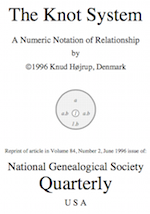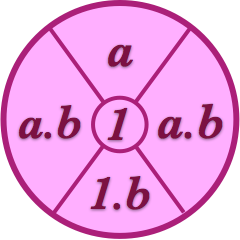The Knot System defined
Definition of The Knot System
Based on the Sequential System, the Knot System recognizes the three basic ways in which individual A may be blood related to individual B:
- A is ancestor to B.
- A is descendant of B.
- A and B have a common ancestor C.
Proband
A proband is the individual to whom relationships are calculated.
Ascent list n
An ascent list n consists of all individuals who link a person to his
or her ancestor at position n, the person and the ancestor are included. Ascent list 1 consists
only of the person.
Knot individual
A knot individual is an ancestor common to both the proband and the related person. The Knot individual must be the
only individual appearing on both of the ascent lists that link the three persons together.
KinCode element
A KinCode element is expressed as a.b - where a represents the ascent list that link the proband
to the knot individual and b represents the ascent list that link the related person to the same individual.
The KinCode element represents an exact description of any one basic relation between the proband and the relative. The number of generations between the proband and the relative equals the sum of the number of generations expressed by each of the two ascent lists
KinCode
The KinCode of a related individual contains all known KinCode elements that link the individual to the proband.
The KinCode elements must be arranged in numerical ascending order within the KinCode, and every element must be
different from all other elements.
Primary and secondary KinCode
The primary KinCode always contains the KinCode element with the smallest number of generations between the proband
and the related individual. In case of more than one element having the same lowest number of generations, the
numerically smaller element is selected, together with its possible mate element.
A mate element is one in which the numbers on each side of the decimal point are odd numbers, each being one number higher than the corresponding part of the basic element.
An element pair is preferred as the primary KinCode over a single element, even when the single element is numerically smaller than the first of the pair. The remaining KinCode elements of the relative's KinCode constitute the secondary KinCode.
Kin group
A kin group is composed of all individuals related to the proband. It may be reduced in size by specifying a maximum
number of generations to ascend from the proband, plus a maximum number of generations to descend from the ancestors.
Or the kin group could be confined to all relatives within a total number of generations distance from the proband.
Kin register
A kin register is a list of all individuals in a kin group. Its main sorting criterion is the individual's primary
KinCode.
Special case
Identical twin, triplets etc. to and clones of the proband are special cases and their KinCode is defined to be:
1.01 which gives these individual types their correct place in Kin registers closest to the proband, and their
relationship coefficient to the proband will be correctly calculated to 1 corresponding
to 100% identical genes.
KinCode properties
Because of the inherent binary structure of bisexual procreation many properties may be derived directly from the Knot Systems KinCode element. Among these:
Main group
The form of the element immediately reveals to which of the three main groups of a Proband's
Kin the related individual belongs regarding each element:
| KinCode | Main group of relatives | |
| 1.b | Descendants of the Proband. | |
|---|---|---|
| a | Ancestors to the Proband. | |
| a.b | Descendants of the Proband's ancestors. (Collateral relatives) |
Relationship coefficient
The distance
in number of generations n between the proband
and the relative may be calculated directly from the elements two ascent lists, and may be used to calculate
the relationship coefficient for each KinCode element.
Generation
The related individual's generation relative to the probands, may be calculated directly from
the two ascent lists.
Gender
The gender of the Knot individual is given by the part of the element that is not equal to 1, even
number is male, odd is female.
Relationship type
Pure male (Agnatic) relationship exists for
KinCode elements, where both the integer and the fraction part is a power of 2
(2, 4, 8, . .).
Pure female relationship exists for KinCode elements where
both the integer part and the fraction part is a power of 2 minus 1
(3, 7, 15, . . ).



